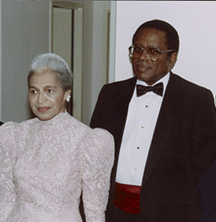What else of value could I learn about Rosa Parks by viewing the new exhibit about her, I thought? It seems like I have read enough and seen enough about the American Civil Rights icon. I even visited the Rosa Parks Memorial and the National Memorial for Peace and Justice in Montgomery. However, I did not realize that my perceptions of her had huge gaps until I took the time to view Rosa Parks: In Her Own Words exhibition, which is now open at the Library of Congress in Washington and online indefinitely.
Learning more about her racial background, education, and political affiliations added new dimensions in my mind about Parks and underscored what historian C.R. Gibbs has advised me to do: research and read for myself and don’t rely on historical movies for information.
While the curators at the Library of Congress did the research, reading about her multi-racial background and seeing blown-up images of her ancestors explains her skin tone and hair texture, while making those Facebook posts on who “is really authentically Black; therefore, for the people” even more trivial.
Ironically, as I digested her multi-racial heritage, I was reading in the exhibition notes that when then Rosa McCauley met her husband to be, Raymond Parks, she “thought he was too White,” but was impressed with his character and defiant attitude.
Rosa Parks: In Her Own Words Exhibition
Praising the Past


Some of Parks’ ancestors were formerly educated. After marrying in 1932, she earned her high school degree in 1933 with her husband's support - - which made her more educated than most Blacks in Montgomery. Her handwritten notes and letters showed that her teachers taught her great penwomanship.
Her political and religious affiliations were even more complex than others often project. Historians often picture her as a middle of the road NAACP supporter, but she grew up with her grandfather armed to defend their home from Klansmen. He was also a follower of pan-Africanist Marcus Garvey.
She was a member of the African Methodist Episcopal Church and later included Buddhist practices in her daily living. Even while firmly footed in the Black activist status quo, she did not shy away from “militants” such as Angela Davis. Louis Farrakhan spoke at her funeral.
As Gibbs would say to me, instead on depending upon a movie to better understand Parks, I encourage you read about Rosa Park in her own words.
Note: A book companion to the new exhibition has the same title, “Rosa Parks: In Her Own Words.”
Read Also: Passenger Jane Gunter and Attorney Fred Gray Added to Rosa Park's Story
Her political and religious affiliations were even more complex than others often project. Historians often picture her as a middle of the road NAACP supporter, but she grew up with her grandfather armed to defend their home from Klansmen. He was also a follower of pan-Africanist Marcus Garvey.
She was a member of the African Methodist Episcopal Church and later included Buddhist practices in her daily living. Even while firmly footed in the Black activist status quo, she did not shy away from “militants” such as Angela Davis. Louis Farrakhan spoke at her funeral.
As Gibbs would say to me, instead on depending upon a movie to better understand Parks, I encourage you read about Rosa Park in her own words.
Note: A book companion to the new exhibition has the same title, “Rosa Parks: In Her Own Words.”
Read Also: Passenger Jane Gunter and Attorney Fred Gray Added to Rosa Park's Story
Advertisers | Contact Us | Events | Links | Media Kit | Our Company | Payments Pier
Press Room | Print Cover Stories Archives | Electronic Issues and Talk Radio Archives | Writer's Guidelines






